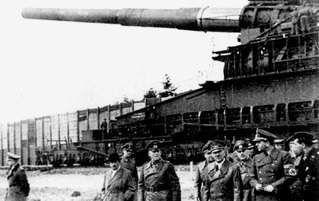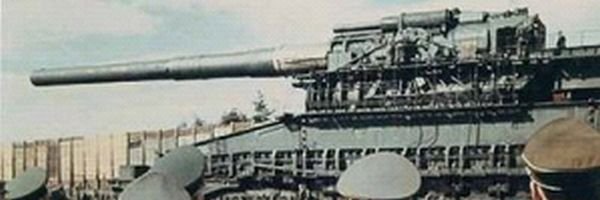The 6 Most Gigantic Everything in the History of War

In the words of Mahatma Gandhi, "War makes people act like dicks." We don't want to glorify war or otherwise portray it as something other than terrible. Yet, war makes people think big, and sometimes you have to sit back and be amazed by what humans can accomplish when they really, really want to kill each other.
The Big Gun: The Schwerer Gustav

The Gustav is the biggest gun ever fired in combat, period.
"Heavy Gustav," as the Germans called it, was 150 feet-long and weighed 2.7 million pounds (or, as much as 750 full-sized sedans). If you're having trouble grasping the scale of this monster, let's look at the shells it fired:

That's not a toy tank sitting in this thing's shadow. The shells were 11 feet-long, and nearly three feet wide. They weighed 14,000 pounds. The Gustav could hurl them 23 miles. It took a half hour just to load it.
If you're wondering why the war didn't end the moment they rolled this terror onto the battlefield, you have to realize how laughably impractical the thing was. It took 250 men to get it assembled and ready to fire, then another 2,500 to lay twin rails for the damn thing just so they could move it towards Russia, the only country on Earth large enough for Heavy Gustav to hit.

It was basically a weaponized suspension bridge.
The Germans actually tried to fit Gustav's 800 millimeter gun onto a tank, the aptly-named Landkreuzer P. 1500 Monster (yes, Monster). Fortunately, it never left the drawing board of a man who we suspect had a very small penis.

The Big Battle: The Battle of Kursk

The Battle of Kursk was Germany's ill-fated blitzkrieg against the USSR in 1943, the Third Reich's Hail Mary play following the epic ass-kicking they had just suffered at Stalingrad.

Also known as "The Battle of That Building Where Sergei's Mom Used to Live."
How serious were they about the Battle of Kursk? Look what they brought:
Almost 800,000 men. About 3,000 tanks. More than 2,000 planes. Nearly 10,000 cannons and mortars.
It would be one of the largest attack forces ever assembled in human history. What could possibly stop it? How about the single most powerful defense force ever assembled? The Soviets caught wind of the force the Nazis were massing, and reinforced the region with this:
Nearly 2,000,000 men. More than 5,000 tanks. More than 25,000 big guns and nearly 3,000 aircraft.
The Soviet defensive line alone was more than 150 miles long, and 95 miles deep. They dug 3,000 miles of trenches, and planted a million landmines. Once it was show time in July 1943, you had the best the Germans had versus the best the Soviets had in the largest toe-to-toe battle in human history.

Who won? Well, the Soviets became the first military to ever stop a blitzkrieg. But holy shit it wasn't easy. By the time the Nazis decided they'd had enough, over 6,000 destroyed German and Soviet tanks sat burning on the battlefield. As many as 5,000 aircraft lay scattered in smoking hunks of twisted metal.
More than one million uniformed corpses littered the ground.
To put it in perspective: that's more losses than every war in American history up to that point put together. And remember, although large enough to be passed off as its own freaking war, the Battle of Kursk was just one battle in the larger Eastern Front of WWII.

"I may be out of line here guys, but this almost seems like too much war."
Keep in mind, about 80 percent of the losses were on the Soviet side. It didn't matter. While the Germans never recovered from their bloodbath at Kursk, the Red Army needed only one new wave of draft-slips to get back up to their old numbers.

"They will choke on our dead!"
The Big Explosion: The Messines Mines

The Messines were 19 enormous mines that were detonated during WWI in the largest planned explosion in history until the atomic bomb came along. Back then, there was only one surefire way to blow a hole in the planet large enough to create a haunted lake: combine lots of state-sponsored TNT with a maniac who thinks big.

TNT: It's Not Just For Coyotes Anymore
General Herbert Plumer of the British Army was just such a maniac. He was trying to win the Battle of Messines at the time and, knowing that there are few problems that cannot be solved by a big enough explosion, he spent 18 months planning the single deadliest non-nuclear blast in history.

"Surely this will draw attention from my droopy hat."
The operation called for 21 massive mines--and by massive, we're talking more than 50,000 pounds of explosives per mine. Six hundred tons total. All of this would be stashed inside almost five miles of tunnels they dug right under where the Germans were standing.
When they finally punched the big red button, the Earth-shaking blast was enough to kill 10,000 Germans, win the battle and tear the planet 19 new assholes which ranged from 105- to 260-feet across.
Wait, did we say 19? What happened to the other two bombs?
They didn't go off. Then they forgot about them.
The two "mislaid" mines were helpfully left buried in the Belgian countryside by the British army until one exploded on June 17, 1955 after being struck by lightning and killing a cow (researchers have confirmed this to be the single unluckiest cow in the history of existence). As for the other, it's been narrowed to an unspecified location in present-day Belgium that top ranking British officials refer to as "we have no goddamned idea."
The Big Unit: 442nd Regimental Combat Team

So it's World War II and, during one of the bigger dick moves in American history, the U.S. government starts sending Japanese-Americans to internment camps.

To defend against the very real threat illustrated here by Dr. Seuss.
What you may not know is that some Japanese-Americans not stranded behind barbed wire actually fought in the U.S. military, a few thousand of them in the 442nd Regimental Combat Team. And they performed pretty well.
And by "pretty well" we mean the 3,800 Japanese-American Rambos in the 442nd won 18,143 awards. That's not a typo. While serving in Africa, Italy, France and Germany, they won a mind-boggling 21 Medals of Honor, 52 Distinguished Service Crosses, 560 Silver Stars, 4,000 Bronze Stars and 9,486 Purple Hearts.
Wait. See that last number? Did you remember that those 9,486 Purple Hearts were earned by just 3,800 men? That's two and a half serious battle wounds per soldier.

That's nearly as many battle wounds as there are Uruk-hai in this picture.
The 442nd also received a total of seven Presidential Unit Citations, five of which were earned in a single month, for acts of heroism that included the rescue of the "lost battalion," a regiment that had been isolated and trapped by enemy forces. That was a group of more than 200 men who got surrounded by the Nazis and saw two previous attempts at rescue fail. Then the 442nd stepped up and, after five days of vicious fighting where they suffered 800 casualties, got them out.

It was like saving 230 Matt Damons.
The Big Sea Battle: The Battle of Lake Poyang

It makes sense that when talking about the biggest anything, China is going to show up on the list. We could have gone for the obvious and pointed out that gigantic wall of theirs, but they're also responsible for what is to this day the largest naval battle in history. And it happened way back in 1363.
Accounts say hundreds of boats and around 850,000 sailors from the combined fleets of the Han and the Ming navies met in Lake Poyang. The Han by far had the larger navy, which consisted of 11 squadrons and more than 600,000 men equipped with what the Han called lou chuan , which were essentially floating fortresses, crammed with troops.

Yes, that dude on the left has a flamethrower.
So, just to recap, that's a Han fleet twice the size of the entire U.S. Navy, armed with warships the size of elementary schools versus a "smaller" Ming fleet of 200,000 sailors.
And although Lake Poyang is the largest freshwater lake in China, the summer sun "had already caused the lake's water level to drop considerably." They were essentially fighting the largest naval battle in history in an enormous bathtub with a hole on the bottom.
The winning strategy wound up being fittingly insane for such a battle. The Ming constructed several "fire ships," that is, kamikazes filled full of explosives and the most flammable shit they could find. They staffed these boats with fake sailors made of straw to fool the enemy, then sent them downwind toward the Han. Flames roared through the decks of the Han ships, burning tens of thousands of men alive.

By the end of the fight, the Ming had won and a few hundred thousand sailors were floating dead in the water. To this day, Poyang Lake is considered the Bermuda Triangle of China, with constant reports of ships disappearing without a trace. We're going to venture a guess that it has something to do with several hundred thousand angry sailor ghosts.
The Big General: Subutai

If the goal of war is to conquer land, then Subutai "the Brave" is the single most successful general in history.

If the goal of war is to grow fantastic facial hair, the most successful general is Ambrose Burnside.
As a teenager from a modest background he signed up with Genghis Khan simply because it seemed like something cool for him and his older brother to do that afternoon. It turned out he was really, really good at it. By the time he was done, his army would conquer 32 nations, win 65 major battles and overrun more territory than any other commander in history. He is also the only person to conquer Russia.
Armed with Chinese technology, a vast spy network, and the best army any nation would see until WWII, Subutai led the invasion of Persia before marching west and coming this close to making all of us part-Mongol. Once Genghis died, his successor Ogedei Khan immediately dispatched Subutai to ride west until he hit the Atlantic Ocean. At that point Subutai's cavalry could cross 270 miles of Eastern European snow, sleet, and ice--in the dead of winter--in only three days, and the Mongolian spy network stretched as far as England.

Oh yeah, lots to spy on there.
Once, in 1241, Subutai destroyed the entire armies of Poland and Hungary in two separate battles, in two different countries more than 200 miles apart, on enemy territory, on consecutive days. During the Hungarian battle, Subutai devised a strategy that would lead to the slaughter 40,000 enemy soldiers, while losing less than 1,000 of his own.
And he did all of it while looking like this:

Do you have an idea in mind that would make a great article? Then sign up for our writers workshop! Know way too much about a random topic? Create a topic page and you could be on the front page of Cracked.com tomorrow!
How else can you ruin your child's life? We thought you'd never ask; check out 9 Toys That Prepare Children for a Life of Menial Labor and The 5 Creepiest Sex Scenes in Comics.
And stop by our Top Picks (Updated 04.30.10) to see what God looks at on the Internet..
And don't forget to follow us on Facebook and Twitter to get sexy, sexy jokes sent straight to your news feed.